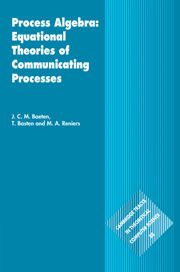Book contents
- Frontmatter
- Contents
- Foreword
- Foreword
- Foreword
- Preface
- 1 Process algebra
- 2 Preliminaries
- 3 Transition systems
- 4 Basic process theory
- 5 Recursion
- 6 Sequential processes
- 7 Parallel and communicating processes
- 8 Abstraction
- 9 Timing
- 10 Data and states
- 11 Features
- 12 Semantics
- Bibliography
- Index of Symbols and Notations
- Index of Authors
- Index of Subjects
7 - Parallel and communicating processes
Published online by Cambridge University Press: 05 July 2014
- Frontmatter
- Contents
- Foreword
- Foreword
- Foreword
- Preface
- 1 Process algebra
- 2 Preliminaries
- 3 Transition systems
- 4 Basic process theory
- 5 Recursion
- 6 Sequential processes
- 7 Parallel and communicating processes
- 8 Abstraction
- 9 Timing
- 10 Data and states
- 11 Features
- 12 Semantics
- Bibliography
- Index of Symbols and Notations
- Index of Authors
- Index of Subjects
Summary
Interleaving
So far, the focus has been on sequential processes: actions can be executed, or alternatives can be explored, starting from a single point of control. In this chapter, the step is taken towards the treatment of parallel or distributed systems: it is allowed that activities exist in parallel. Just allowing separate activity of different components is not enough. A genuine treatment of parallel activity requires in addition a description of interaction between parallel activities.
Suppose there are two sequential processes x and y that can execute actions, and choose alternatives, independently. The merge operator ‖ denotes parallel composition. Thus, the parallel composition of x and y is denoted x ‖ y. To illustrate the intuition behind the algebraic treatment of parallel composition, consider an external observer O that observes process x ‖ y. Observations can be made of executions of actions. Assume that these observations are instantaneous. Then, it can be seen that the observations of actions of x and actions of y will be merged or interleaved in time.
Consider the example a.0 ‖ b.0. This process involves the execution of two actions, one from each component. Observer O might see the execution of a first, and then the execution of b. After this, no further activity is possible. On the other hand, observer O might see the execution of b first, then the execution of a followed by inaction. Finally, the observer might observe the two actions simultaneously.
Information
- Type
- Chapter
- Information
- Process Algebra: Equational Theories of Communicating Processes , pp. 195 - 244Publisher: Cambridge University PressPrint publication year: 2009
